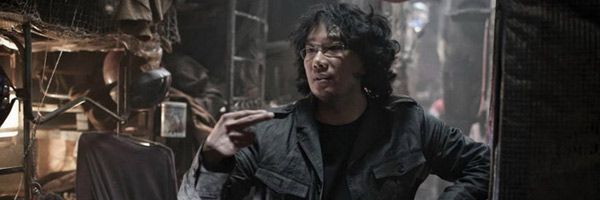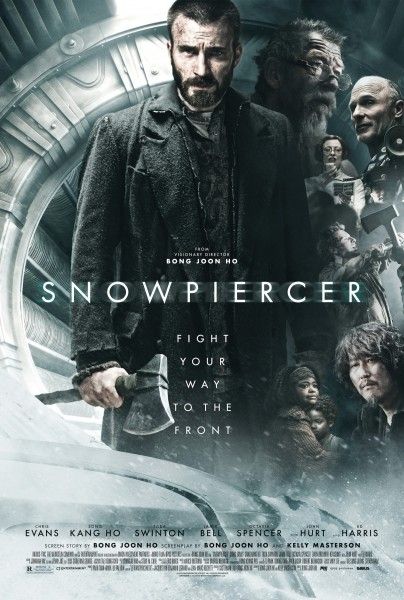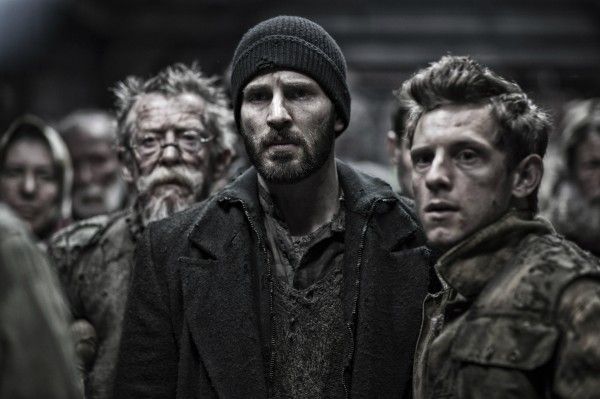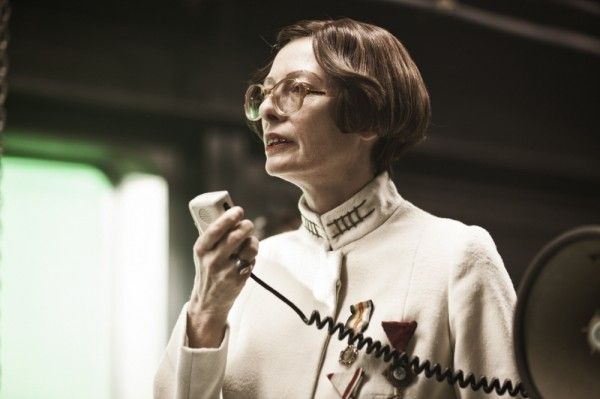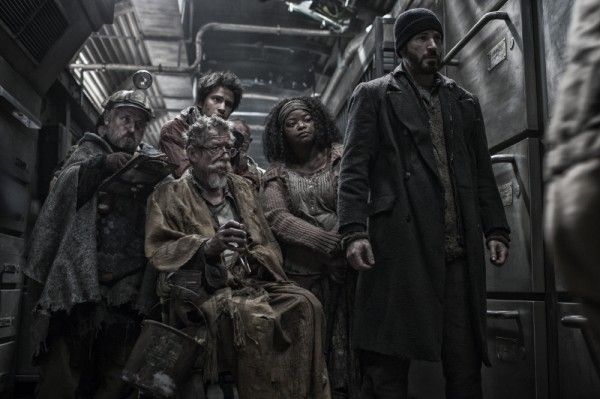From director Bong Joon-ho and adapted from the French graphic novel “Le Transperceneige,” Snowpiercer tells the story of what happens after Earth has been frozen for 17 years, making the planet uninhabitable, and the few who are still alive are separated by class and now live aboard a train that perpetually circles the world. When a young leader (Chris Evans) from the slum-like tail section decides to start a riot, his fellow passengers charge toward the engine located at the front of the train, where they seek to gain absolute authority.
At the film’s press day, Korean filmmaker Bong Joon-ho spoke to Collider in both a 1-on-1 and roundtable interview where he talked about how universal the themes of this film are for audiences, what excited him about bringing this story to the big screen, how much of the graphic novel is in the film, designing the visuals for the train cars, how the use of a gimbal influenced his direction, the experience of shooting his first English language film, why he wanted actor Chris Evans for the lead role, and how close the finished movie is to his original storyboards. He also talked about how he’s currently writing two scripts from original ideas, and that he’d like to shoot one movie, every two years. Check out what he had to say after the jump.
Question: You’ve been talking about this movie for the past year, in Korea, France, Japan, China, Germany and now the U.S. Do you find that everybody has different reactions to the film, or are they all reacting in the same way?
BONG JOON-HO: It’s almost the same. Because it’s a sci-fi movie, the theme is very universal, with rich people and poor people fighting on a running train.
When you first read this graphic novel, was it something you immediately saw, both visually and cinematically?
BONG JOON-HO: The very first thing that made me excited was the train. I could make a train movie with the material. The idea of shooting a two-hour movie inside of a moving train with people fighting inside it was very exciting and thrilling. Also, the strong contrast between narrow and long, the overpopulated, cramped spaces inside, and the darkly lit spaces and the beautiful white outside, it’s very poetic and lyrical. I liked that contrast. The train has many separated sections. Every time you open a door and go into another section, it’s an opportunity to show different worlds. Also, the idea that, one by one, you progress through the cars of the train with Chris Evans, it’s not like the audience sees what’s ahead of him. They are with him, and they experience it simultaneously with him. There’s an excitement to that.
How much of the graphic novel was incorporated into the film, and how much of the film is your own aesthetic style?
BONG JOON-HO: The script is based on the graphic novel and the key ideas are there, such as the survivors on a moving train. Also visually, there are some things, like the greenhouse, that is in the original comic book. But in terms of design and visuals, my art team and production design team pretty much created the world of Snowpiercer. Because the comic book has been published here in the U.S., you can see the differences.
The visuals for the train cars are so powerful, with their underlying social commentary. How did you go about designing and selecting what visuals you would include from society, in the various train cars?
BONG JOON-HO: We designed and built 26 different train cars, but because we had a limited budget, we had to plan ahead and use everything that we shot. But if you look at it on a bigger scale, you can take the greenhouse section and the water section of the train, and divide it in two. If you go to a fancy hotel or department store, there are the areas where the customers go and it is very nicely decorated and luxurious, but then if you turn a corner into a hallway, you will see where just the staff goes, and there is exposed concrete and pipes, and it is dirtier. I wanted to give that feeling in the train. In the movie, you get to the greenhouse, and after that, you see the aquarium and the swimming pool, and you see where all of the rich people live. It is one train, but you see two different worlds inside of it. And then, at the very front is the engine. The design of the engine is different from the comic book.
So much of this film was shot with practical vs. CG. How did the gimbal influence your direction?
BONG JOON-HO: Sometimes we felt carsick on set. You really feel the effect of the gimbal in the beginning of the film, where you see Tilda [Swinton] make her speech. When she is doing the speech with the shoe, you can see down the tail section people and the movement. On set, I really felt like I was inside of a train. Also there are no windows in the tail section, so the gimbal is really important. The sections with the windows, you can see the outside environment passing. But in the tail section, there are no windows, so the gimbal was essential to give that feeling of a train.
How did you adjust to shooting your first English language film?
BONG JOON-HO: It was not so difficult because we had such great translators on set. I actually made a movie in Japan in 2007, with Japanese crew members and Japanese actors, and I was a little bit nervous because I can’t understand the Japanese language, at all. But the very first day of shooting was okay because the Japanese actors and I shared the same emotion. The interpretation of the script was the same as I wrote it. Even shooting a movie in Korea, in Korean, sometimes I am on set with actors who don’t get along or they don’t understand, and they argue. It is very tiresome. It is really about the project and the similarity in emotion about a project. The language is secondary.
How did you decide on Chris Evans? Was he someone you were familiar with, or was he suggested to you?
BONG JOON-HO: The casting director recommended him, initially, and said that he’s not just about the Marvel movies. Of course, Captain America is a cool character and he’s great in that, but they introduced me to a movie called Puncture, that’s an indie film where he shows his sensitive acting abilities, and I’d previously seen Danny Boyle’s Sunshine. So, he was in between his Marvel projects and was very actively looking for different types of projects. He heard about this project, and it was a nice mutual attraction. It was my first English language film, and I got a lot of help from Chris. He’s a really smart guy, and we had a lot of discussions about the dialogue. It was great. The hardest thing about working with Chris was hiding his muscles. He’s supposed to be in the poor tail section for 17 years, eating only protein blocks, and it was tricky to hide all of that muscle mass with costume and make-up.
You spent quite awhile writing this script before shooting it. Were there any major changes, along the way?
BONG JOON-HO: The writing process did take a little bit longer, just because I wrote the draft first, and then I worked with Kelly Masterson on the English language dialogue. Also, because the budget was limited, I had to make the edit decisions ahead of time, on paper, and make the choices for what to shoot and what not to shoot. There are 26 different train cars, and they all show different varieties of the world in the film. We tried to lower the budget, and there were suggestions from the producers to cut certain train cars, but that was something that I couldn’t compromise on. I had to shoot that the way it was written.
Did you have a longer first cut that you had to edit down, or is what we’re seeing now what you wanted?
BONG JOON-HO: I always make my own storyboards, by myself. Snowpiercer was the same way. And the final movie is not so different from the original storyboards.
All of your actors talk about what a meticulous director you are and that you’re a perfectionist. Is that why you didn’t want to do the edits and voice-over recording that the Weinstein Company wanted you to do, and why you wanted to keep your cut intact?
BONG JOON-HO: I’m a control freak. Working in Korea, I’m used to having full creative control. It’s not an unusual set-up. That’s just how it’s been, since I’ve been making movies since the late ‘90s. The Weinstein Company also has their way of doing things, and I respect that, but it’s just different from what I’m used to. A director’s job is really about shot construction and figuring out how to cut a scene and what to shoot. That’s the essence of the job. It’s not an arbitrary thing, where you get on set and try this and try that. You have to have a clear vision and guide the other people that are working with you to create this film.
What’s next for you?
BONG JOON-HO: I am writing two scripts that are based on my original ideas. One is a Korean movie, and one is a mixed international co-production. These two projects are smaller budget, and smaller than Snowpiercer. For me, Snowpiercer is a big-budget movie. In Hollywood, it is a middle or small sized movie, but for me, in Korea and Asia, it is a big-budget movie. I hate big-budget movies. I want to make smaller movies, in the future.
It took four years since Mother for you to make Snowpiercer. Do we have to wait another four years for you to make the next film?
BONG JOON-HO: I really want to make movies faster. Snowpiercer took four years because the prep period was very long. For the rest of my life, I’d like to shoot one movie, every two years.
Snowpiercer opens in theaters on June 27th.

